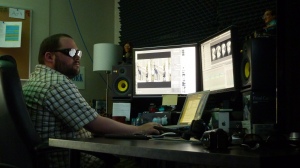Editing a 3D documentary: working with two audio channels in Cineform Neo3D
Looks like we’ll have to find a workaround for the audio issue we’ve encountered with Cineform Neo3D software in order to edit our first 3D documentary.
As I’ve mentioned, the 3D files that Cineform creates only have two audio tracks.
To capture ambient noise as well as a conversation between two subjects for the explosive demolition show Blowdown, we have to capture at least three channels (a boom mic and two lavs), sometimes four (camera mic).
Our editor, Brian Mann, has been in conversation with Cineform developers to see if we could find a way to edit with more than two channels.
They’ve been very prompt in replying and helpful.
But unfortunately it looks like there’s no way to edit more than two channels of audio using the current version.
There’s no particular reason why the program’s this way – it’s just a design factor that isn’t optimal for our specific post production needs.
As far as we’re concerned it’s the best high-end game in town, and otherwise it’s working great.
Cineform’s lead Mac engineer plans to add it to the list of things to add to their future release, First Light.
In the interim, we’ll have to figure out how to adjust our workflow.


